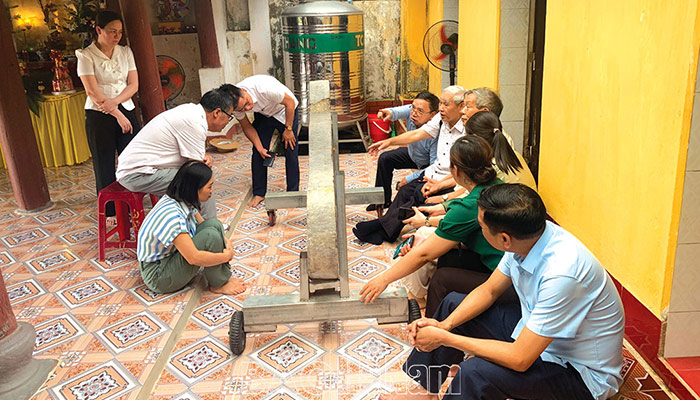Dieu Pagoda’s Stone Gong – A Precious Treasure of Ha Nam
After centuries of change, Dieu Pagoda (also known as Dieu Tu), located in Dong Tu hamlet, Vu Ban commune, Binh Luc district, still retains its ancient charm and distinct cultural-architectural values from the Later Le dynasty. The most unique feature of this temple is its ancient stone gong - a rare treasure considered one of the most valuable artifacts in Ha Nam province. Created in 1692 during the reign of King Le Hy Tong, this gong served not only as a musical instrument in Buddhist rituals but also embodies profound historical, artistic, and spiritual significance.
Exquisite Carving Artistry

The stone gong at Dieu Pagoda has impressive dimensions: 0.95 meters tall, 1.45 meters wide, 0.7 meters thick, and weighs around 300 kg. It is one of the rare stone gongs meticulously carved on both sides, displaying remarkable balance and detail in its craftsmanship.
Front Side – A Masterpiece of Carved Symbolism
At the center is a large bodhi leaf - a key symbol in Buddhism representing enlightenment. Inside the leaf is a circular sun-like motif, symbolizing radiant wisdom illuminating all directions. On either side of the leaf are two gracefully curved dragons facing inward. These dragons have crests, large bulging eyes, wide mouths, and sinuous bodies with three claws on each foot - conveying majesty and sacredness. The gong’s neck is divided into two unequal sections containing sunken Han characters, recording key historical details and the merits of those who contributed to its creation. Below, a pair of phoenixes dance toward the center, symbolizing the harmony of yin and yang, prosperity, and enduring wealth.
Back Side – Harmony of Art and Eastern Philosophy
Unlike the elaborate front, the gong’s back exudes a quieter beauty full of philosophical depth. Its top is left plain, focusing instead on spiritual Han inscriptions. The bold line “Loi thanh pho hoa thien ton” (Thunder's voice spreads divine enlightenment) evokes the image of thunder reverberating through the heavens, conveying spiritual awakening. Below, two smaller lines express blessings: “Year by year – rising fortune, Day by day – flourishing life,” conveying aspirations for abundance and fulfillment. Flanking the sides are descending dragons with bulging eyes, open mouths, coiled three-section bodies, and curling tails, signifying divine protection over the temple and its devotees.
A Valuable Historical Record from the 17th Century
Beyond its artistic worth, the stone gong also functions as a stele preserving critical information about society during the Le Trung Hung period. Engraved on its surface are 46 Han characters, listing those who contributed to the construction of the pagoda and the gong itself. Notably, the names include Tran Viet Nho, a high-ranking court official and physician, and his wife Tran Thi Nhan - along with their family and local dignitaries who joined efforts to create this masterpiece.
Furthermore, the inscriptions reflect the philosophy of “Three Teachings in One” - a harmonious blend of Buddhism, Confucianism, and Taoism. This fusion is illustrated through iconic motifs:
Front Side – A Masterpiece of Carved Symbolism
At the center is a large bodhi leaf - a key symbol in Buddhism representing enlightenment. Inside the leaf is a circular sun-like motif, symbolizing radiant wisdom illuminating all directions. On either side of the leaf are two gracefully curved dragons facing inward. These dragons have crests, large bulging eyes, wide mouths, and sinuous bodies with three claws on each foot - conveying majesty and sacredness. The gong’s neck is divided into two unequal sections containing sunken Han characters, recording key historical details and the merits of those who contributed to its creation. Below, a pair of phoenixes dance toward the center, symbolizing the harmony of yin and yang, prosperity, and enduring wealth.
Back Side – Harmony of Art and Eastern Philosophy
Unlike the elaborate front, the gong’s back exudes a quieter beauty full of philosophical depth. Its top is left plain, focusing instead on spiritual Han inscriptions. The bold line “Loi thanh pho hoa thien ton” (Thunder's voice spreads divine enlightenment) evokes the image of thunder reverberating through the heavens, conveying spiritual awakening. Below, two smaller lines express blessings: “Year by year – rising fortune, Day by day – flourishing life,” conveying aspirations for abundance and fulfillment. Flanking the sides are descending dragons with bulging eyes, open mouths, coiled three-section bodies, and curling tails, signifying divine protection over the temple and its devotees.
A Valuable Historical Record from the 17th Century
Beyond its artistic worth, the stone gong also functions as a stele preserving critical information about society during the Le Trung Hung period. Engraved on its surface are 46 Han characters, listing those who contributed to the construction of the pagoda and the gong itself. Notably, the names include Tran Viet Nho, a high-ranking court official and physician, and his wife Tran Thi Nhan - along with their family and local dignitaries who joined efforts to create this masterpiece.
Furthermore, the inscriptions reflect the philosophy of “Three Teachings in One” - a harmonious blend of Buddhism, Confucianism, and Taoism. This fusion is illustrated through iconic motifs:
- Buddhism: The bodhi leaf, sun circle, and the words "Spring, Summer, Autumn, Winter" signify eternity.
- Confucianism: Dragons flanking the bodhi leaf symbolize power and morality.
- Taoism: Spiral dots on the dragons’ heads represent cosmic energy and supernatural force.
A National Treasure of Vietnamese Stone Carving
The stone gong of Dieu Pagoda holds extraordinary value, fully deserving recognition as a national treasure. Over 300 years old and unique in its design, it stands out among Vietnam’s rare collection of stone gongs. Each carved pattern and symbol reflects a fusion of Buddhist, Confucian, and Taoist thought - offering a vivid glimpse into the religious and social life of the Le Trung Hung era.
The Han inscriptions engraved on the gong also serve as precious historical records. In addition to praising ancestral virtues, they provide insights into local governance, community structure, and religious customs of the time. These inscriptions offer future generations a window into the cultural and historical fabric of a bygone era.
More than just a Buddhist ritual object, the stone gong is a “time monument” - preserving memory, spirit, and ancestral knowledge. It is a vital cultural heritage that deserves to be safeguarded, honored, and shared.
Preservation and Cultural Continuity
Preserving the Dieu Pagoda stone gong is not solely the responsibility of heritage professionals - it requires collective community awareness and care in protecting cultural values. Scientific and sustainable preservation practices are essential, including environmental control, minimizing weathering and moisture, and limiting direct human contact.
Beyond physical preservation, education and outreach are equally crucial. Exhibitions, research, and community learning programs highlighting the gong’s historical and artistic significance can help spread its value more broadly within society.
Integrating preservation with spiritual tourism development also offers a path to keep the monument alive in contemporary life. Visitors not only admire its aesthetic but also experience cultural depth, gaining understanding of a centuries-old spiritual and historical tradition.
As community awareness grows, each person becomes a “guardian of memory.” In this way, the Dieu Pagoda stone gong will continue to endure as a living symbol of history - a masterpiece of Vietnamese traditional art proudly passed to future generations.
More than a mere provincial artifact, the Dieu Pagoda stone gong holds a special place in the grand tapestry of Vietnamese traditional arts. With over three centuries of history, it embodies timeless values - spiritual essence, cultural depth, and the pinnacle of stone carving.
For all these reasons, the gong rightfully belongs on the list of national treasures. Preserving and promoting its value reflects our gratitude to ancestors and contributes to sustaining Vietnam’s cultural heritage.
If you ever find yourself in Phu Ly or Binh Luc district of Ha Nam, don’t miss a visit to Dieu Pagoda - home to this 300-year-old stone gong. Amid the tranquil, ancient space, you’ll not only witness traditional architecture but also touch the depths of Vietnam’s cultural soul.
The stone gong of Dieu Pagoda holds extraordinary value, fully deserving recognition as a national treasure. Over 300 years old and unique in its design, it stands out among Vietnam’s rare collection of stone gongs. Each carved pattern and symbol reflects a fusion of Buddhist, Confucian, and Taoist thought - offering a vivid glimpse into the religious and social life of the Le Trung Hung era.
The Han inscriptions engraved on the gong also serve as precious historical records. In addition to praising ancestral virtues, they provide insights into local governance, community structure, and religious customs of the time. These inscriptions offer future generations a window into the cultural and historical fabric of a bygone era.
More than just a Buddhist ritual object, the stone gong is a “time monument” - preserving memory, spirit, and ancestral knowledge. It is a vital cultural heritage that deserves to be safeguarded, honored, and shared.
Preservation and Cultural Continuity
Preserving the Dieu Pagoda stone gong is not solely the responsibility of heritage professionals - it requires collective community awareness and care in protecting cultural values. Scientific and sustainable preservation practices are essential, including environmental control, minimizing weathering and moisture, and limiting direct human contact.
Beyond physical preservation, education and outreach are equally crucial. Exhibitions, research, and community learning programs highlighting the gong’s historical and artistic significance can help spread its value more broadly within society.
Integrating preservation with spiritual tourism development also offers a path to keep the monument alive in contemporary life. Visitors not only admire its aesthetic but also experience cultural depth, gaining understanding of a centuries-old spiritual and historical tradition.
As community awareness grows, each person becomes a “guardian of memory.” In this way, the Dieu Pagoda stone gong will continue to endure as a living symbol of history - a masterpiece of Vietnamese traditional art proudly passed to future generations.
More than a mere provincial artifact, the Dieu Pagoda stone gong holds a special place in the grand tapestry of Vietnamese traditional arts. With over three centuries of history, it embodies timeless values - spiritual essence, cultural depth, and the pinnacle of stone carving.
For all these reasons, the gong rightfully belongs on the list of national treasures. Preserving and promoting its value reflects our gratitude to ancestors and contributes to sustaining Vietnam’s cultural heritage.
If you ever find yourself in Phu Ly or Binh Luc district of Ha Nam, don’t miss a visit to Dieu Pagoda - home to this 300-year-old stone gong. Amid the tranquil, ancient space, you’ll not only witness traditional architecture but also touch the depths of Vietnam’s cultural soul.










